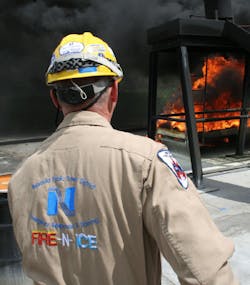Industrial Firefighter Training Series Released by Action Training Systems
Industrial fire brigades provide the first line of defense against fires at nuclear power plants, coal plants and many other industrial sites with industrial-sized hazards. Members of these firefighting forces at one of Nebraska’s nuclear power plants and coal-fuel power plant are shown in Industrial Fire Brigades, a multimedia training series by Action Training Systems. This firefighter training series teaches to the requirements of NFPA 1081, a national professional standard for industrial fire brigade members.
Given the current backdrop of global concern for nuclear power safety, training for the personnel that fight fires behind the gates of the nation’s nuclear power plants is paramount. Industrial fire brigade training gives these on-site workers the ability to prevent or safely extinguish the flames before they become disasters that affect their communities.
As Fire/Safety Lead of the Nebraska Public Power District, John Shrader is in charge of training the industrial fire brigades at Cooper Nuclear Station in Brownville, Neb., and Gerald Gentleman Station, a coal plant in North Platte, among others. He attributes much of the plants' successful track record to the training of his industrial fire brigades.
"We use the training to impress upon our fire brigade members, especially in the initial training, how quickly a small event can turn into a large event, and how prevention can really pay off down the road," he said. One challenge for Shrader and other instructors training industrial fire brigades has been that good classroom materials designed specifically for the needs of industrial fire brigade members haven't been widely available. "There's a host of manuals and other materials for municipal firefighters out there," said Shrader, "but industrial firefighting is very specialized."
Cooper maintains extensive training fields and a Learning Center equipped with a simulator. In the Learning Center, instructors can take control room crews through realistic training of an accidental plant shutdown. "They initiate simulated actions to the point where they break the plant. Then they take a break and when they come back they're at full power. With a fire, it's much harder to do that in the training room." With a new 23-part multimedia training series designed for training industrial fire brigades by Action Training Systems, that has changed. Showing fires and fire control by real fire brigade members is Industrial Fire Brigades: Incipient Level and Industrial Fire Brigades: Exterior & Structural. Shrader appreciates the quality of the content because his crews provided many of the demonstrations, which were shot on location at Cooper Nuclear Station and Gerald Gentleman station in 2009 and 2010. Industrial fire brigades at sites across the United States and Canada participated in the development of the series.
"The training is as close to reality as you can get it, but at the same time, it always emphasizes the safety aspects of the response – how to respond to dangerous situations," said Shrader.
Instructors can now run students through the training on DVD or computer-based training in a classroom environment before students begin hands on training. "Each video starts at the basic level, but as the video progresses the level of knowledge progresses as well," said Shrader. The programs teach specifically to the skill and knowledge requirements of NFPA 1081, Standard for Industrial Fire Brigade Member Professional Qualifications. The first series of 12 programs helps train industrial fire brigade members to the incipient level, providing the capability to extinguish small fires while wearing normal work clothing.
The second series teaches to the advanced exterior and interior structural levels of NFPA 1081. The programs provide step-by-step demonstrations for using personal protective clothing, SCBA, hoselines, ladders, search and rescue techniques, access and forcible entry equipment and techniques, water supply, ventilation, foam operations and the basic techniques for controlling interior and exterior industrial fires, including tank fires.
Action Training Systems is a multimedia development company and worldwide leader in providing innovative training systems for emergency responders. The company provides quality video demonstrations on DVD and interactive computer-based training (CBT) programs and simulator programs on the Iluminar Learning Management System (LMS) software platform. All programs are reviewed by renowned subject matter experts aiding in content creation through the production of multimedia training tools, which is why ATS is renowned for its exceptional real life content.
Action Training Systems produces training programs for firefighters in the private and public sector based on nationally accepted training standards and only uses real industrial fire brigade and fire department personnel to ensure the integrity and authenticity of the skills that are demonstrated and captured on video. Other training systems include municipal firefighter training, EMS, HAZMAT, Fire Service Rescue, The Essentials of Fire Fighting and more. For more information, visit www.action-training.com.
